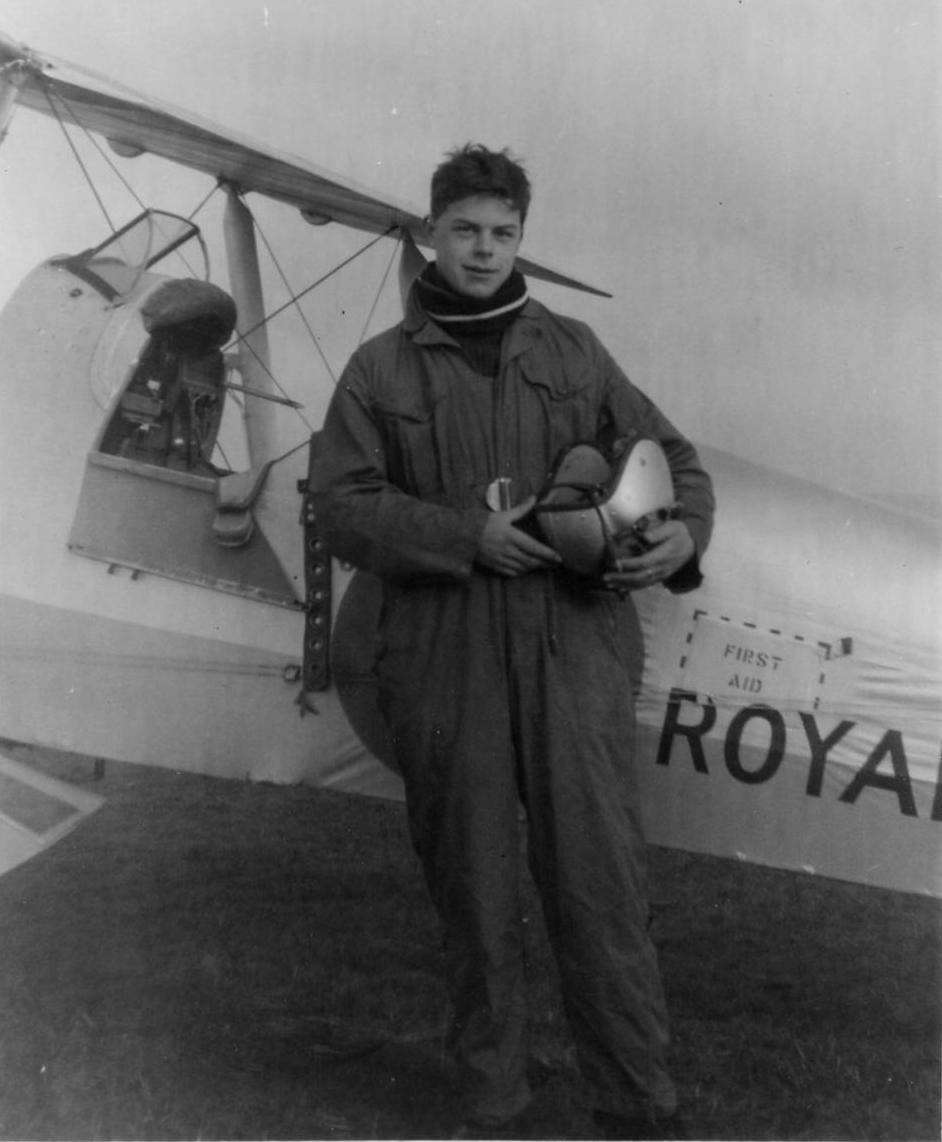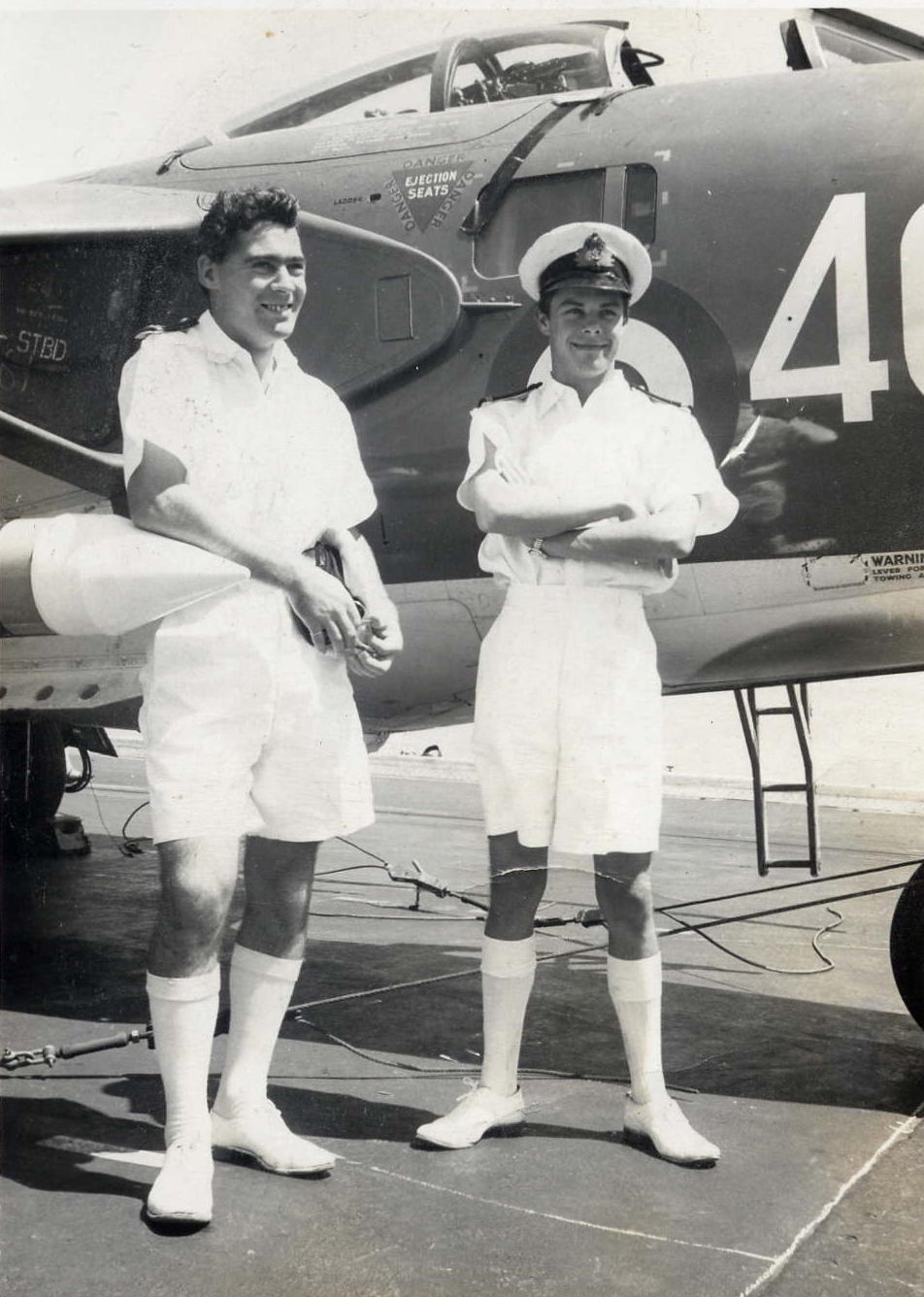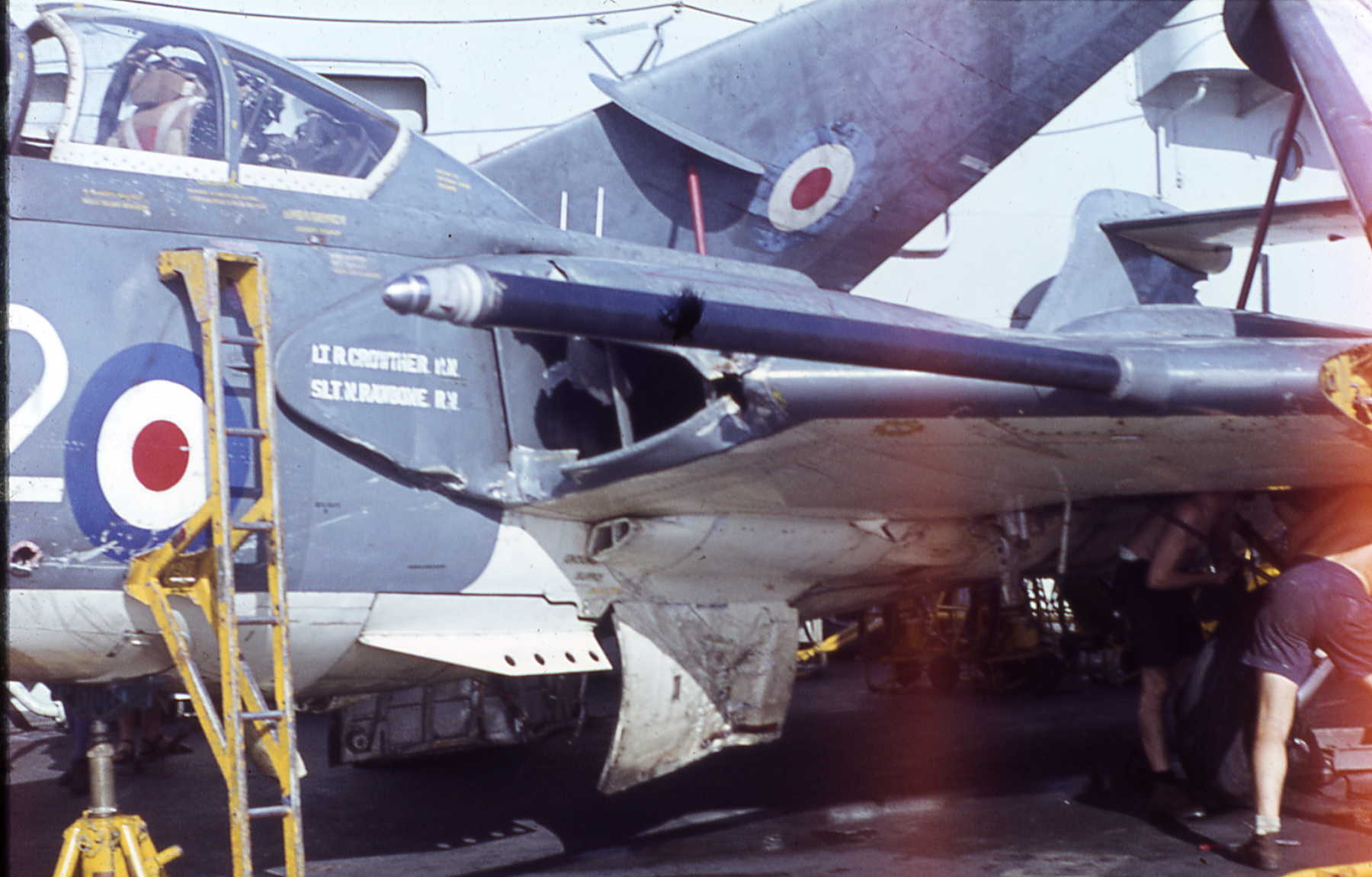
REMEMBERING BOB WOOLLEY
By Mark Woolley
Part 1. 1960 to November 1964

Above: a young Bob Woolley pictured at Roborough in December 1960 shortly after joining the Royal Navy
It is hard to believe that it is now over 40 years ago that my father, Robert (Bob) Woolley, crashed fatally in a Meteor T7 whilst on a test flight from the Bournemouth (Hurn) Airport based Fleet Requirements Unit. At the time he was only 26 years old and it was a tragic end to a Naval flying career which had once seemed to offer so much.
Whilst the 1960’s are sometimes portrayed as a period of rapid decline for the Fleet Air Arm, a review of my father’s flying log reveals an impressive variety of postings and of aircraft types flown. I hope that you will therefore find the following brief story of his career - the story he was never able to tell himself - of some interest.
Like many who flew in the Fleet Air Arm, my father had an ambition to become a pilot at a very early age and by the time he was 17 much of his spare time was taken up with flying Jackaroos and Tiger Moths with the Royal Air Corps from such locations as Thruxton and Shoreham. Shortly after his 18th birthday he gained his private pilots licence.
Bob Woolley joined the Supplementary List of the Royal Navy in September 1960 and, following two terms at Britannia Royal Naval College Dartmouth, enrolled at the No. 1 Flying Training School, RAF Linton-On-Ouse (no. 99 Royal Naval Course) for training to Wings standard in Jet Provosts and Vampires. Following presentation of his Wings in September 1962 he joined 738 Squadron at RNAS Lossiemouth for Operation Flying School (OFS) training in the recently delivered Hunter T8s and GA11s. After successfully graduating from Naval Air Strike School in February 1963 he went on to 766 Squadron, the All Weather Fighter Squadron down at RNAS Yeovilton for six months intensive OFS2 training in Sea Vixen FAW1s where he was paired with regular observer Sub-Lieutenant Barry Hughes (pictured). The syllabus included extensive night flying (nearly 40% of total hours), much high level flying, several Aerodrome Dummy Deck Landings (ADDLs), live firestreak firing, a generator failure (!) and more than one instance of Mach 1.2.
After over 480 hours flying and many more hours in the classroom the initial training was finally completed on 26th July 1963 when my father qualified as a Naval Fighter Pilot. Now it was time for some front line flying.

S/Lt. Bob Woolley (right) with regular observer S/Lt. Barry Hughes on HMS Victorious
He joined the Sea Vixens FAW1s of 893 Squadron, under the command of Lt. Cdr. Ken Kemp, on HMS Victorious in August 1963 for an eventful fourteen month deployment to the Far East. This took in, amongst others, Aden, Singapore (Tengah), Hong Kong (Kai Tak), Japan, Nairobi, Dar-es-Salam and Australia. Victorious had been commissioned earlier than originally scheduled in order to relieve HMS Ark Royal which had suffered mechanical problems and both the Vixens of 893 and the Buccaneer S1s of 801 Squadron embarked as she steamed hurriedly down the English Channel from Portsmouth.
Trying to select some highlights of this period for the purpose of this article has not been easy. One could easily end up writing a whole book on this part of Victorious’ history alone and, as was often the case, there was plenty of unscheduled activity as well as routine flying. On the scheduled front, there were several exercises including two major ones in the shape of ‘Exercise Jet 64’ and ‘Exercise Ligtas’. The first work-up took place off Aden two weeks after leaving Portsmouth and, following stays in Singapore and Hong Kong, the second one took place at the US Navy range in Subic Bay in the Philippines during November 1963. The Commander (Air) on Victorious at the time, Cdr. Keith Leppard (now Captain K.A. Leppard CBE RN) recalls that, despite his limited experience in the Sea Vixen, the very youthful looking Bob Woolley proved to be an “absolute natural at rocket firing”. He was also very capable when it came to firing Bullpup missiles and to his credit was awarded a bottle of champagne by Commander Leppard on 11th November for scoring two successive direct hits on the USAF air to ground target at Tabones Island, also in the Philippines (picture below). The Bullpup must surely qualify as one of the most unusual weapons ever to be used by the Royal Navy in that the pilot had to continue flying his aircraft towards his target after releasing the missile, controlling the aircraft with one hand and the trajectory of the Bullpup with the other. 893 Squadron’s firing figures from this session make interesting reading: total number fired 14, hits 7, near misses 3, misses 2 and uncontrollable 2.

Above: Being presented with a bottle of champagne by the Commander (Air), Cdr. K.A. Leppard RN, following consecutive direct hits with live Bullpup missiles on Tabones Island - a USAF air to ground target near Subic Bay in the Philippines. Observer Barry Hughes looks on. (© Crown Copyright)
‘Exercise Jet 64’ took place in March 1964 between the Nicobar Islands and Penang and also involved ships from the Australian, New Zealand and Canadian Navy as well as the Indian carrier Vikrant. Sorties included several strikes including four separate ones with live 1000 lb. bombs. ‘Exercise Ligtas’ in May 1964 (back in Subic Bay) proved to be the largest exercise of the Commission with over 90 ships from the UK, US, Australia, New Zealand and the Philippines forming a large SEATO fleet. 893 Squadron’s role during the exercise was to provide Combat Air Patrols, Strikes and Close Air Support during amphibious landings. Also during the exercise there was time for a spot of in-flight refuelling with a Douglas Skyhawk of the US Navy. The conclusion of Ligtas saw a fly-past over Victorious organised in honour of FO2 Far East Fleet, Vice Admiral Scratchwood CB DSC, who was retiring from the active list and my father flew one of the three Sea Vixens that represented the squadron during this salute.
Less predictable were the world’s political problems and whilst off Gan in late January 1964 Victorious was ordered to east Africa to assist in steps being taken to resolve the Tankanikan uprising. A very buoyant 45 Commando, Royal Marines, were embarked from HMS Centaur and with up to 600 men bedding down in ‘A’ and ‘B’ hangars Victorious must have resembled more of a troop ship than an aircraft carrier during this time. Needless to say there was not much opportunity for flying until, with the tensions ashore having eased, the Vixens of 893 disembarked to Embakasi Airport in Nairobi. During their brief stay the squadron provided close air support for the RAF flying in reinforcements and my father flew eight sorties including one (a low level battle formation) with Captain Kingston of the Green Howards as his observer.
More significantly, Victorious’ arrival in the Far East coincided with the escalation of the Indonesian Confrontation with Malaysia and 893’s Sea Vixens played an active part in controlling the situation. In particular, whilst in hostile waters near the Lombok Strait during the return from Fremantle to Singapore in September 1964, circumstances were extremely tense with Victorious on Condition II and even a War State for a period. Whilst the ship had been in Australia, President Sukarno of Indonesia had taken it upon himself to extend his territorial waters thus cutting off international rights of passage through both the Sunda and Lombok Straits. This situation was unsurprisingly totally unacceptable to the British government and, having picked up additional aircrew at Christmas Island, Victorious proceeded along the edge of the Indonesian Defence Notification Zone. The Sea Vixens were ready to scramble at very short notice, fully armed with two firestreaks and two full 2” rocket pods. In view of the fact that President Sukarno had placed a bounty on the head of any British serviceman, the aircrew's equipment was also supplemented by a 9mm pistol.... Matters came to a head on 16th September when a TU-16 Badger of the Indonesian Air Force was shadowing the carrier and when it turned directly towards Victorious and into international airspace my father was scrambled to intercept it. Neville Davies, who was the Air Staff Officer on Victorious, clearly recalled to me nearly 40 years later how my father subsequently elaborated to him on the contents of his official combat report and how he had "carried out recognised international interception procedures":
"Well", he said," I came up alongside him, all my missiles had acquisition and the cockpit was lit up like a bloody Christmas tree. I only had to press the tit and he was a goner. He knew it and I knew it. As he looked at me I gave him a "V" sign and he waved and went home!"
On arrival back at Singapore Victorious was placed in dry dock for five weeks and 893 Squadron was placed under RAF Far East Command. The Vixens proceeded to relieve the RAF’s Gloster Javelins of much of the intruder patrol work along the Malaysian coast. Unfortunately the spirit of goodwill was not helped by the fact that the RAF were at first reluctant to allow the Fleet Air Arm to use their air-conditioned facilities. Consequently the Squadron ended up camping under canvas at the end of Tengah’s runway. This intolerable situation, with deafening jet noise, rain and mud aplenty was only resolved following the personal intervention of Captain D.L. Davenport RN who had recently assumed command of Victorious. Like all who saw active service in the Confrontation my father received the Campaign Medal.
Earlier, on April 14th 1964, all those hours of flying training suddenly came to good effect during dusk DLP in Sea Vixen XJ572 off Singapore. Due to the Confrontation, 893 were flying very hard under the leadership of Ken Kemp and in due course the whole Squadron had become ‘night deck-qualified’. Lt. Frank Craig (now Captain F.G. Craig RN) who was one of the Squadron’s engineering officers vividly recalled in a letter to me: “I was duty squadron engineer on the flight deck when Bob approached for a practice ‘touch and go’ landing. On touching the deck there was a loud bang and some sparks but he successfully got airborne again. Initially we thought he had blown the port main tyre. The barrier was rigged as it would have been impossible to carry out a normally arrested landing. Although very inexperienced in night deck landings (only his 3rd time), your father took the barrier in copy-book style. Landing safely, he slewed to port and ended up rather near the port catwalk. No one was hurt much to the relief of everyone. In the after flight investigation it transpired that it was the oleo and not the tyre that had caused the problem – both tyre and wheel were missing!”
Above: the scene on HMS Victorious shortly after S/Lt. Woolley's night barrier landing on 14th April 1964 (© Crown Copyright)

Above: the damaged XJ572 seen after day break. This Vixen would subsequently be offloaded at Hong Kong and did not fly again until it had been converted to a FAW2 at De Havilland's factory in Chester. (© REM Woolley)
I know for a fact that my father was unsurprisingly quite shaken by this incident and is quoted in the Flight Deck crew’s report in the Book of the Commission as saying that it “was like flying into a brick wall”. Judging from photographs taken in the aftermath, with the barrier firmly embedded in the airframe, it is not too difficult to appreciate this. 130 knots to zero would appear to have been achieved in something less than the normal three-and-a-half seconds. Certainly Commander Leppard was suitably impressed with my father’s handling of the rare ‘night barrier engagement’ and felt able to recommend him for official praise. As a result, a month later FOAC, Rear Admiral H.R.B. Janvrin CB DSC, awarded him a Green Endorsement for “showing considerable coolness” during the emergency.
I am in no doubt that, despite the night barrier scare, my father viewed his time with 893 Squadron as the highlight of his career. However, November 1964 eventually arrived, and 183 deck landings later, it was time to move on. The journey home to London involved a long flight as, unsurprisingly, the continuing unrest in Malaysia had resulted in the decision being made to commence Victorious’ next Commission in Singapore – and not back in Portsmouth as originally planned.
Go to 'Remembering Bob Woolley - Part 2'
Last updated: 26th July 2009